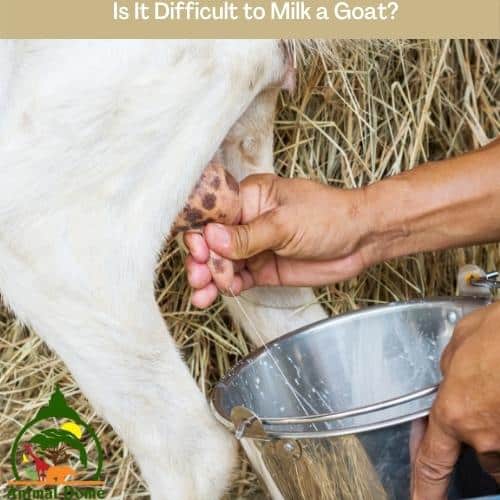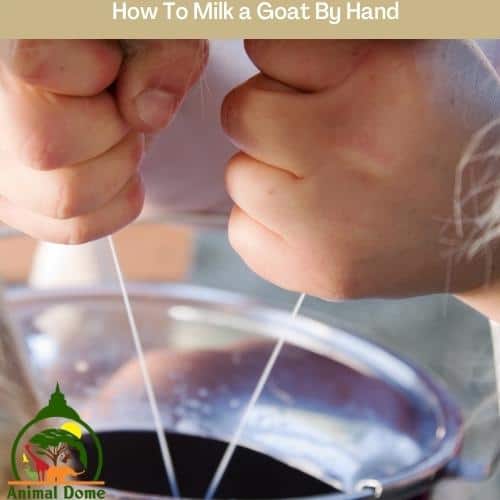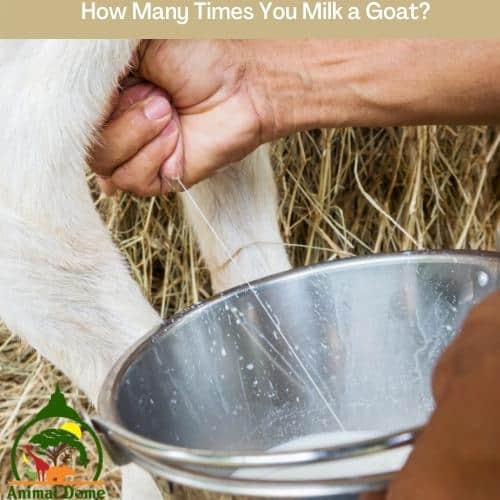Goats are among the oldest domesticated animals in the world, and their milk has been a staple in many cultures for thousands of years. They are a popular source of milk, and their milk is used in a variety of products, from cheese to soap.
But how are goats milked? In this blog post, we’ll take a look at the process of milking goats, from start to finish.
Let’s jump right in
Is It Difficult to Milk a Goat?

It is not difficult to milk a goat. In reality, the actual goat milking portion of the homesteading duties only takes around five to fifteen minutes every day.
Nanny goats must be milked every day when nursing in order to produce a continuous supply of milk. Before you collect milk from a female goat, she must be pregnant and have given birth. The body of a doeling or nanny goat is virtually never ready to expel milk (lactate) until she has kidded (given birth) and has to furnish milk for the young goats.
To milk a goat, you must tightly grab the top of the goat’s teat and then squeeze it down with your fingers. When you squeeze, don’t let go of the teat with your forefinger and thumb. Otherwise, the milk will flow back up the mammary gland and there would be nothing to squeeze out.
Mullins’ goats are “extremely food-motivated creatures,” and would gladly cooperate if it meant getting to eat from a trough of goat feed. She consumes around 350 pounds of food every week to feed her goats. That means two hours of goat milking in the morning and two hours in the evening for her every day.
Do Goats Have to Be Pregnant to Give Milk?
Unfortunately, goats cannot make milk until they are pregnant (how amazing would it be if they could produce milk regardless of pregnancy?).
After the goats have given birth, you can begin milking them within a few weeks. Goats typically begin breeding at the age of 18 months. It is usually not safe for them to begin this process before they are 12 months old.
When a goat becomes pregnant, she must have her babies before you can begin milking her. This is best done two weeks after the babies are born. Pregnant goats may lactate for up to ten months after birth, providing you nearly a year of milk-collecting time to enjoy both your taste buds and your wallet.
Not only that, but goats may become pregnant while nursing. Your goat can remain pregnant and nursing for the remainder of her natural life after she reaches maturity (approximately 10–12 years on average).
That’s a long time to benefit from her milk production, which is one of the reasons dairy goat farming is so profitable. Now that we’ve established what it takes for a goat to begin nursing, let’s look at how you may milk your goat in order to get the best out of it, for both us, and the animal.
Safe Ways To Milk A Goat
There are two widely used ways to milk goats. They are;
How To Milk A Goat By Machine
Step 1:
Use the silicone gasket to seal the can or bucket to the top of the pail and a plastic brace to hold it in place.
Machine milking appears to be the more successful and simple approach. The following processes actually take longer than it does to milk a goat.
Step 2:
The pump should start suctioning after a few seconds, and the vacuum gauge should read between 10 and 12 inches.
Step 3:
Remember that goats prefer to have the same milking schedule every day, so don’t mess up your schedule too much.
Step 4:
After cleaning her udder, you will extract milk into a cup to check for any abnormalities, such as blood. In this manner, you can see if the milk is okay and get rid of any bacteria that may have leaked out initially. It’s a risk-free measure.
Step 5:
The milk will pass through the expansions in about 3 to 4 minutes. When the milk has stopped flowing, break the pull on each teat and remove the expansion. Start the extract, insert the teats into the inflation, and watch as the milking begins.
Step 6:
After milking, clean the goat’s teats and udders again and spray with Fightback. Weigh the can to determine how much milk she delivers (weighing is optional). Remember to give the goats new hay after milking. This allows the wax fitting to shift closer to the teat’s end.
Step 7:
After milking all of the goats, remove the lid from the milk container, stack it on top of the rinse cans, and bring the milk pail inside.
Step 8:
It is never a good idea to mix heated milk with cooled milk. In general, it is best to chill the milk as quickly as possible while avoiding any rewarming plans. Pour the milk through a milk filter funnel into clean glass containers, cover the containers, and chill immediately.
Step 9:
Warm water and bleach are used to clean the milk machine. This is another critical step that must be completed without fail. After you’ve disposed of the water-bleach solution, hang the bucket to dry until the next time it’s needed.
How To Milk a Goat By Hand

Provided the goats are all set and ready for milking, the following are a few easy steps to follow in milking your goats manually.
Step 1:
Extraction of milk from goats would be less stressful and more enjoyable with a simple idea like an old breast pump. Without supported measures, it can become time-consuming and result in adverse outcomes. Planning a proper measure ahead of time might save you a lot of difficulties.
Step 2:
Never pull on your goat’s coat during milking, since you should strive to trap the milk in the teat. Again, tugging will provide negative, if not zero, outcomes.
Step 3:
Manual milking is difficult, and it may take 30–40 minutes at first. With a lot of experience, you’ll be able to get to the point quickly and milk a goat in under 5 minutes.
The storing methods will be the same as when machines are used.
How Many Times You Milk a Goat?

How many times should a goat be milked? The frequency is determined by whether or not they have a baby to feed.
Unless she has just given birth, a doe, or female goat, will not produce milk. Age, breed, nutrition, and other factors all influence how much milk goats produce.
Milking a goat produces the same response in her body as feeding her babies, causing her to continue producing milk. So long as there is enough feed, the more frequently you milk a goat, the more milk it will produce.
Freshening a goat is the process of mating her with a buck, or male goat, many months after giving birth in order to keep milk production going.
You should not start milking a goat just after she gives birth. She gives her children breast milk for eight weeks before weaning them. If your goat only has one child or if the offspring are being fed with formula, you can milk the goat twice daily at 12-hour intervals. If you wish to introduce your children to formula, wait at least one week before milking and taking them from their mother.
Allowing the goat’s udder to expand and remain full without milking might lead her to become highly uncomfortable and begin to suffer discomfort. Goats produce milk on demand and must be milked or fed to empty their udders.
FAQ
What Happens if You Don’t Milk a Goat?
It will create discomfort, agony, and even health concerns if you don’t milk a dairy goat. The udders of the goats will uncomfortably swell with milk. Mastitis, an infection of the udder, is also a possibility. You should only stop milking your dairy goat if you are intending to dry her out.
How to Milk a Goat With Mastitis?
The only actual difference in the procedure will be quarantined from other goats and other comparable safety precautions. To help cure mastitis, milk out the afflicted side of the udder, but take extra precautions. You shouldn’t drink the milk, though some would argue that it’s just OK.




